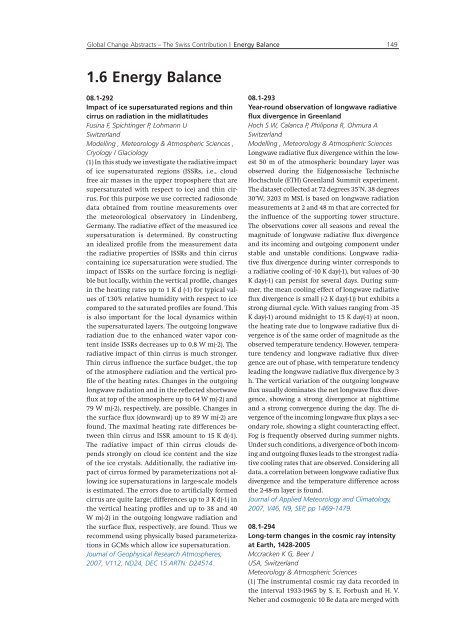Global Change Abstracts The Swiss Contribution - SCNAT
Global Change Abstracts The Swiss Contribution - SCNAT
Global Change Abstracts The Swiss Contribution - SCNAT
You also want an ePaper? Increase the reach of your titles
YUMPU automatically turns print PDFs into web optimized ePapers that Google loves.
<strong>Global</strong> <strong>Change</strong> <strong>Abstracts</strong> – <strong>The</strong> <strong>Swiss</strong> <strong>Contribution</strong> | Energy Balance<br />
1.6 Energy Balance<br />
08.1-292<br />
Impact of ice supersaturated regions and thin<br />
cirrus on radiation in the midlatitudes<br />
Fusina F, Spichtinger P, Lohmann U<br />
Switzerland<br />
Modelling , Meteorology & Atmospheric Sciences ,<br />
Cryology / Glaciology<br />
(1) In this study we investigate the radiative impact<br />
of ice supersaturated regions (ISSRs, i.e., cloud<br />
free air masses in the upper troposphere that are<br />
supersaturated with respect to ice) and thin cirrus.<br />
For this purpose we use corrected radiosonde<br />
data obtained from routine measurements over<br />
the meteorological observatory in Lindenberg,<br />
Germany. <strong>The</strong> radiative effect of the measured ice<br />
supersaturation is determined. By constructing<br />
an idealized profile from the measurement data<br />
the radiative properties of ISSRs and thin cirrus<br />
containing ice supersaturation were studied. <strong>The</strong><br />
impact of ISSRs on the surface forcing is negligible<br />
but locally, within the vertical profile, changes<br />
in the heating rates up to 1 K d (-1) for typical values<br />
of 130% relative humidity with respect to ice<br />
compared to the saturated profiles are found. This<br />
is also important for the local dynamics within<br />
the supersaturated layers. <strong>The</strong> outgoing longwave<br />
radiation due to the enhanced water vapor content<br />
inside ISSRs decreases up to 0.8 W m(-2). <strong>The</strong><br />
radiative impact of thin cirrus is much stronger.<br />
Thin cirrus influence the surface budget, the top<br />
of the atmosphere radiation and the vertical profile<br />
of the heating rates. <strong>Change</strong>s in the outgoing<br />
longwave radiation and in the reflected shortwave<br />
flux at top of the atmosphere up to 64 W m(-2) and<br />
79 W m(-2), respectively, are possible. <strong>Change</strong>s in<br />
the surface flux (downward) up to 89 W m(-2) are<br />
found. <strong>The</strong> maximal heating rate differences between<br />
thin cirrus and ISSR amount to 15 K d(-1).<br />
<strong>The</strong> radiative impact of thin cirrus clouds depends<br />
strongly on cloud ice content and the size<br />
of the ice crystals. Additionally, the radiative impact<br />
of cirrus formed by parameterizations not allowing<br />
ice supersaturations in large-scale models<br />
is estimated. <strong>The</strong> errors due to artificially formed<br />
cirrus are quite large; differences up to 3 K d(-1) in<br />
the vertical heating profiles and up to 38 and 40<br />
W m(-2) in the outgoing longwave radiation and<br />
the surface flux, respectively, are found. Thus we<br />
recommend using physically based parameterizations<br />
in GCMs which allow ice supersaturation.<br />
Journal of Geophysical Research Atmospheres,<br />
2007, V112, ND24, DEC 15 ARTN: D24514.<br />
149<br />
08.1-293<br />
Year-round observation of longwave radiative<br />
flux divergence in Greenland<br />
Hoch S W, Calanca P, Philipona R, Ohmura A<br />
Switzerland<br />
Modelling , Meteorology & Atmospheric Sciences<br />
Longwave radiative flux divergence within the lowest<br />
50 m of the atmospheric boundary layer was<br />
observed during the Eidgenossische Technische<br />
Hochschule (ETH) Greenland Summit experiment.<br />
<strong>The</strong> dataset collected at 72 degrees 35’N, 38 degrees<br />
30’W, 3203 m MSL is based on longwave radiation<br />
measurements at 2 and 48 m that are corrected for<br />
the influence of the supporting tower structure.<br />
<strong>The</strong> observations cover all seasons and reveal the<br />
magnitude of longwave radiative flux divergence<br />
and its incoming and outgoing component under<br />
stable and unstable conditions. Longwave radiative<br />
flux divergence during winter corresponds to<br />
a radiative cooling of -10 K day(-1), but values of -30<br />
K day(-1) can persist for several days. During summer,<br />
the mean cooling effect of longwave radiative<br />
flux divergence is small (-2 K day(-1)) but exhibits a<br />
strong diurnal cycle. With values ranging from -35<br />
K day(-1) around midnight to 15 K day(-1) at noon,<br />
the heating rate due to longwave radiative flux divergence<br />
is of the same order of magnitude as the<br />
observed temperature tendency. However, temperature<br />
tendency and longwave radiative flux divergence<br />
are out of phase, with temperature tendency<br />
leading the longwave radiative flux divergence by 3<br />
h. <strong>The</strong> vertical variation of the outgoing longwave<br />
flux usually dominates the net longwave flux divergence,<br />
showing a strong divergence at nighttime<br />
and a strong convergence during the day. <strong>The</strong> divergence<br />
of the incoming longwave flux plays a secondary<br />
role, showing a slight counteracting effect.<br />
Fog is frequently observed during summer nights.<br />
Under such conditions, a divergence of both incoming<br />
and outgoing fluxes leads to the strongest radiative<br />
cooling rates that are observed. Considering all<br />
data, a correlation between longwave radiative flux<br />
divergence and the temperature difference across<br />
the 2-48-m layer is found.<br />
Journal of Applied Meteorology and Climatology,<br />
2007, V46, N9, SEP, pp 1469-1479.<br />
08.1-294<br />
Long-term changes in the cosmic ray intensity<br />
at Earth, 1428-2005<br />
Mccracken K G, Beer J<br />
USA, Switzerland<br />
Meteorology & Atmospheric Sciences<br />
(1) <strong>The</strong> instrumental cosmic ray data recorded in<br />
the interval 1933-1965 by S. E. Forbush and H. V.<br />
Neher and cosmogenic 10 Be data are merged with

















